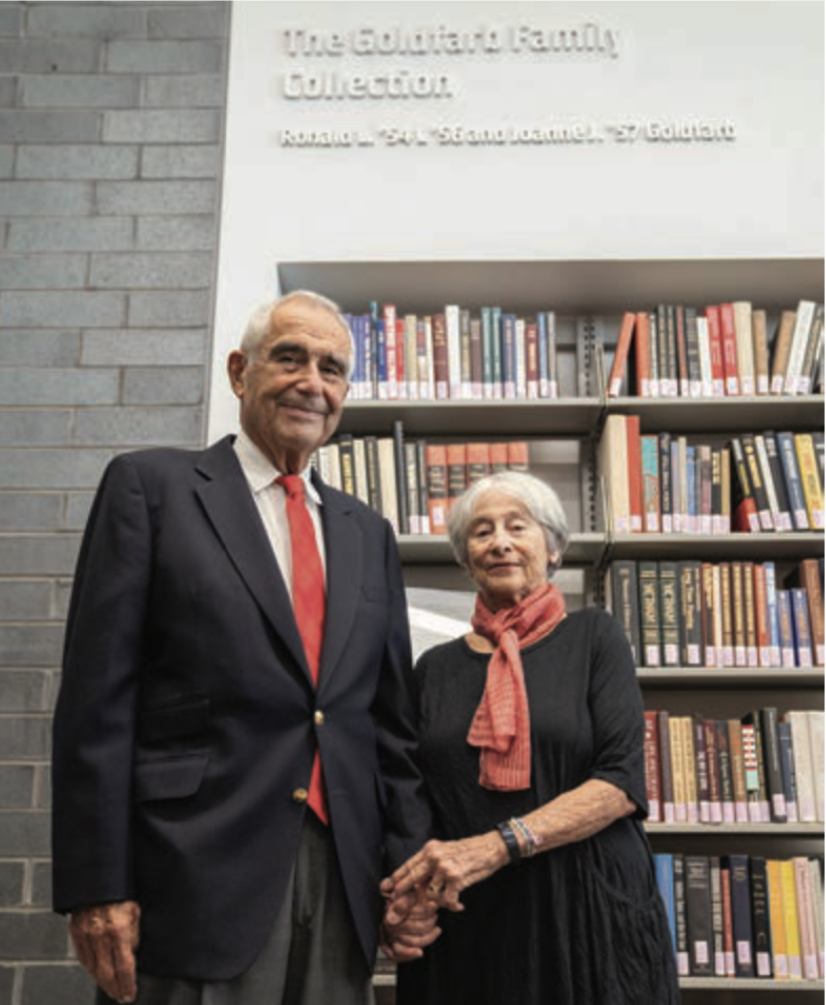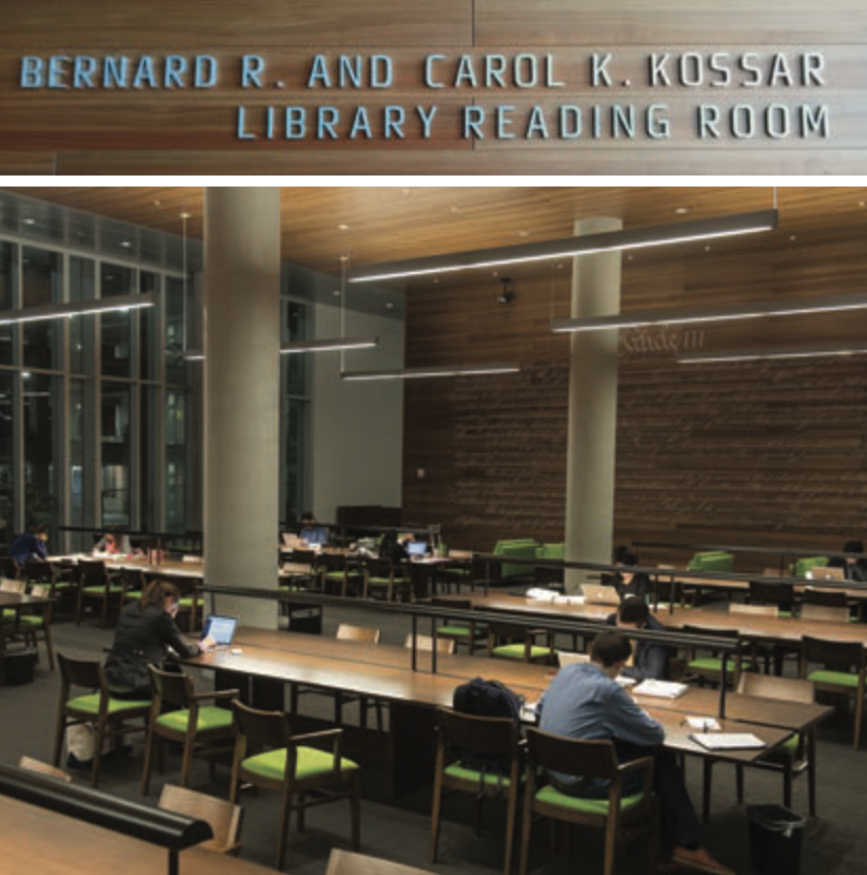
By Jan Fleckenstein G’84, G’86, L’11, Associate Teaching Professor of Law & Director of the Law Library
Over its long history the Law Library has been shaped by librarians, faculty, students, and by the generosity of donors into a vital resource for the study of law and for faculty research that explains and develops the law. Our commitment to service supports all members of the College community, and that commitment is the driving force behind the collections and programs that the library offers.
The library is responsive to student and faculty needs for research and study. It is creative in the way it provides print and electronic resources to support research and the curriculum. And it is collaborative in nurturing networks with the Syracuse University Libraries and other law libraries, as well as with law library consortia across the country and around the world, to maximize our access to the broadest possible range of legal information resources.
Dedicated to Learning
A spectacular Bernard R. and Carol K. Kossar Library Reading Room, divided from the Levy Atrium by a glass wall that soars 19 feet, makes the Law Library a visible symbol of the College’s dedication to study and learning.
A mixture of reading tables, research carrels, study tables, and computer workstations provides students with a choice of study spaces that best meet their individual needs. Wood-paneled, high- density mechanical book stacks, enough to hold 350,000 print volumes, fill the west end of the main floor and the center of the upper floor, leaving room around the perimeter to give library users access to natural lighting and expansive views overlooking the Onondaga Valley and the city of Syracuse. With card-swipe access 24 hours a day, seven days a week, law students can use the Law Library on a schedule that meets their needs: around classes, jobs, and family obligations.
When the library moved to Dineen Hall, it gained its first dedicated special collections space—the Peter Herzog L’55 and Brigitte Herzog L’75 Special Collections Room—as well as space to house College archives. We are now actively growing and curating not only the general collection but also our own collection of items that represent the College over its 125-year history.
The contours of the library’s collection are shaped by requests from students and faculty, by purchases to support specific courses in the curriculum, and by careful monitoring by law librarians of developments in legal scholarship and trends that must be reflected in a broad- based academic library collection.

Interdisciplinary Collection
The permanent print collection forms the backbone of the Law Library’s information resources, including historical collections for research into the evolution of law and legal systems over time in local, state, federal, international, and comparative law. We house 65,521 print titles, augmented by a substantial collection of historical documents on two million pieces of microform. High-quality scanners enable us to convert documents stored in print or on microform into searchable PDFs and send them to users anywhere in the world.
The library is interdisciplinary in its collection policy, supporting research and scholarship in law and economics, politics, history, public policy, and the arts and humanities. This interdisciplinarity is reflected in recent donations such as the Ronald L. ’54, L’56 and Joanne J. Goldfarb ’57 Family Collection, which contains works that represent every intersection of law and society. While the library is open to the University community, the local legal community, and the general public, interdisciplinary works in our collection most often draw library users from outside the College.
To enhance our services, the library takes advantage of every new development in legal information databases and every advance in information technology. Our 247,625 print volumes are complemented by 41,532 electronic books, along with the general legal database services Westlaw, Lexis, Bloomberg Law, and Hein Online, plus individual databases in specialized subject areas.
Moreover, a mix of electronic and print resources provides a comprehensive platform for effectively teaching legal research skills and for helping students find the right information to complete their course assignments and their research projects.
“I most certainly envision a bright future in the law for generations of students to come.”
Rapidly Evolving
Although alumni may not remember it this way, learning to do legal research used to be fairly straightforward: use digests to find cases, use indexes to find statutes, and use the library catalog to find books on specific areas of the law.
That all changed with the introduction and growth of legal databases, which continue to rapidly evolve in content and features. Law librarians now focus on helping students choose the right databases, develop effective search strategies, discern the strengths and weaknesses of various online sources, and develop a sense of how different algorithms affect search results in different legal information products.
The JDinteractive online degree program provided the opportunity for the library to implement its vision of a service model for the future by creating an electronic counterpart to every in- person library function. Law librarians and library support staff leveraged that experience to pivot quickly to providing remote support for the College’s residential programs when the spring 2020 semester unexpectedly moved online during the COVID-19 crisis.
We were ready. By then, in addition to our services inside the Law Library, we already took reference questions through the library website—law.syr. edu/law-library—by email, phone, and text message. We consulted on research questions over Zoom. We checked
out books remotely, shipped books to students, and provided shipping labels to make it easy to send books back. We already scanned and sent documents from the print collection to remote users. In anticipation of the future and continued demand for rapid service, we had already invested heavily in electronic resources and added a few new databases to replicate highly used portions of the print collection.

Suite of Services
The library provides the same robust suite of services to students and faculty remotely as if they were using the library in person.
The library has grown, adapted, and innovated over the past 125 years, in keeping with the mission of the College of Law. Law librarians are versatile in crafting collections and services that support student learning and faculty research. Law librarians who are technical specialists take advantage of new legal information products and electronic services that prepare students to be confident researchers in practice.
Because of our expansive view of the services that an academic law library should offer, our Law Library fulfills the legal information needs of its users, in person and around the world, wherever our academic and research interests take us.
I am honored to serve the College of Law, our students and faculty—and our profession—as Director of the Law Library. Above all, as I walk through the library, browse through our collections, and take stock of what we have built, I can almost hear the quiet whisper of generations past, and I most certainly envision a bright future in the law for generations of students to come.
